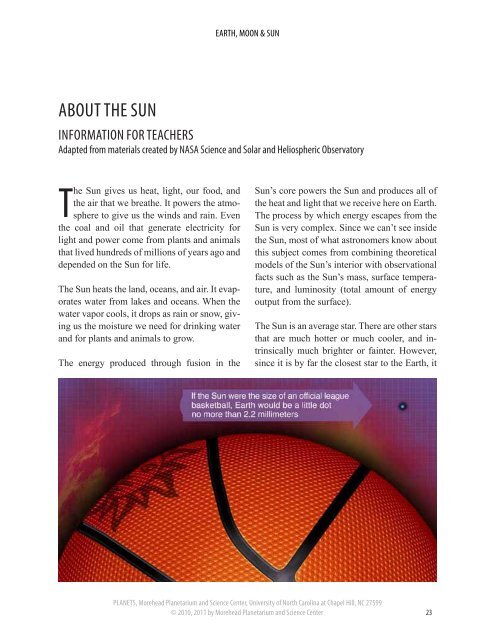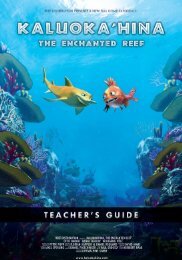EARTH, MOON & SUN - Peoria Riverfront Museum
EARTH, MOON & SUN - Peoria Riverfront Museum
EARTH, MOON & SUN - Peoria Riverfront Museum
You also want an ePaper? Increase the reach of your titles
YUMPU automatically turns print PDFs into web optimized ePapers that Google loves.
<strong>EARTH</strong>, <strong>MOON</strong> & <strong>SUN</strong>ABOUT THE <strong>SUN</strong>INFORMATION FOR TEACHERSAdapted from materials created by NASA Science and Solar and Heliospheric ObservatoryThe Sun gives us heat, light, our food, andthe air that we breathe. It powers the atmosphereto give us the winds and rain. Eventhe coal and oil that generate electricity forlight and power come from plants and animalsthat lived hundreds of millions of years ago anddepended on the Sun for life.The Sun heats the land, oceans, and air. It evaporateswater from lakes and oceans. When thewater vapor cools, it drops as rain or snow, givingus the moisture we need for drinking waterand for plants and animals to grow.The energy produced through fusion in theSun’s core powers the Sun and produces all ofthe heat and light that we receive here on Earth.The process by which energy escapes from theSun is very complex. Since we can’t see insidethe Sun, most of what astronomers know aboutthis subject comes from combining theoreticalmodels of the Sun’s interior with observationalfacts such as the Sun’s mass, surface temperature,and luminosity (total amount of energyoutput from the surface).The Sun is an average star. There are other starsthat are much hotter or much cooler, and intrinsicallymuch brighter or fainter. However,since it is by far the closest star to the Earth, itPLANETS, Morehead Planetarium and Science Center, University of North Carolina at Chapel Hill, NC 27599© 2010, 2011 by Morehead Planetarium and Science Center 23





